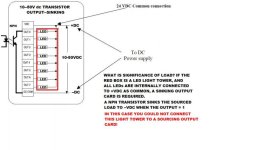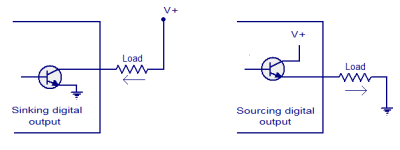What is the significance of sourcing/sinking concept for an output device for selection of output module? For example if the output module is sourcing and the output device is "sinking" you have to connect the positive terminal of the output device to the output terminal of the module and negative terminal to the common of the module. But even if the output device is "sourcing" you can connect the device to the same module by connecting the positive of the device to the common and negative terminal to the output channel of the module. So what is the significance?
You are using an out of date browser. It may not display this or other websites correctly.
You should upgrade or use an alternative browser.
You should upgrade or use an alternative browser.
Clarification on sourcing/sinking concept
- Thread starter Karoly
- Start date
Mickey
Lifetime Supporting Member
See PDF...
bernie_carlton
Lifetime Supporting Member + Moderator
For two terminal load devices they are not inherently 'sinking' or 'sourcing'. It will depend on your choice of wiring them to a common line.
In our applications 24VDC power is bonded to frame ground on the negative side. In our case if the output devices were attached as 'sourcing' (connected to + on a common side) and 'sinking' output modules are used then an inadvertant short to frame of an output wire between the PLC output module and the device would result in a non-controlled turn-on.
Thus, because of our grounding the minus side of the 24 VDC power, we connect all output loads as 'sinking' (connected to the 24 VDC minus) and use 'sourcing' output modules. An inadvertant short to frame would not result in a turn on - though it might affect/destroy the output module if appropriate fusing is not used.
In our applications 24VDC power is bonded to frame ground on the negative side. In our case if the output devices were attached as 'sourcing' (connected to + on a common side) and 'sinking' output modules are used then an inadvertant short to frame of an output wire between the PLC output module and the device would result in a non-controlled turn-on.
Thus, because of our grounding the minus side of the 24 VDC power, we connect all output loads as 'sinking' (connected to the 24 VDC minus) and use 'sourcing' output modules. An inadvertant short to frame would not result in a turn on - though it might affect/destroy the output module if appropriate fusing is not used.
Hate that - I let it float then no issues. Have never had an issue with it floating either.In our applications 24VDC power is bonded to frame ground on the negative side.
You also need to consider whether the load has "polarity", such as a SSR, or even a humble LED.
LED display "modules" may have either a "Common-Anode", or "Common-Cathode", to reduce the number of physical connections needed.
Common-Cathode will need a sourcing output, but Common-Anode will need sinking outputs.
Getting current flowing in the right direction is the key, and remember that solid-state (transistor or FET) outputs only pass current in one direction, unlike relay contacts.
If your output is "sourcing", the remote end of your driven device needs to go to -ve. Conversely, if your output is "sinking", the remote end of your loads are connected to +ve.
LED display "modules" may have either a "Common-Anode", or "Common-Cathode", to reduce the number of physical connections needed.
Common-Cathode will need a sourcing output, but Common-Anode will need sinking outputs.
Getting current flowing in the right direction is the key, and remember that solid-state (transistor or FET) outputs only pass current in one direction, unlike relay contacts.
If your output is "sourcing", the remote end of your driven device needs to go to -ve. Conversely, if your output is "sinking", the remote end of your loads are connected to +ve.
See PDF...
Just gone through Terry's pdf you linked to.
The only concern I will raise is that he has classified the loads as either sourcing or sinking.
IMHO (where H is "humble"), you should not classify the loads themselves as either sourcing or sinking, they don't source or sink anything.
They are just devices in series with the output that is either...
1. "sourcing" conventional current flow (+ve to -ve) to the load, the other end of which is connected to 0v or supply -ve.
Or,
2. "sinking" conventional current flow to 0v or supply -ve, from the load, the other end of which is connected to supply +ve.
The load itself can neither be sourcing, or sinking. These terms can only be given to the arrangement of the "switch" in the PLC output module.
Passive loads are generally capable of current flow in either direction (e.g. resistive loads, like incandescent bulbs, relay coils etc.), and can generally be driven by sourcing or sinking outputs, without worry about polarity (unless the relay has a flywheel diode!!). When used on a sinking output, the remote end of the load is connected to supply +ve. When used on a sourcing output, the remote end of the load is connected to supply -ve.
Of course, if the load can only pass current in one direction, like an LED or opto-coupler, or SSR, then it needs to be connected the right way round, which means it can be driven by a sourcing or sinking output.
I guess I got my answer. For a two terminal device, even if polarity dependent, sourcing and sinking doesnt apply, but for a multiterminal device like an LED display there will be one common which entails sourcing or sinking. Even for two terminal device sourcing and sinking apply if grounding is taken in to consideration. Thank you all.
References to sourcing or sinking has always confused me too. This may not work for everyone but it works for me:
When referring to a device I think about whether I'm switching the DC positive side of the device or the DC negative side of the device. And stay away from thinking about if something is more positive or more negative.
Example: One side of a PNP prox switch connects to the DC+, the other side to the load (PLC input module, light, etc.), and yes, if it's a 3-wire prox a wire also goes to the DC-.
So in my mind I'm switching the positive wire.
Like I said, it works for me.
When referring to a device I think about whether I'm switching the DC positive side of the device or the DC negative side of the device. And stay away from thinking about if something is more positive or more negative.
Example: One side of a PNP prox switch connects to the DC+, the other side to the load (PLC input module, light, etc.), and yes, if it's a 3-wire prox a wire also goes to the DC-.
So in my mind I'm switching the positive wire.
Like I said, it works for me.
What is the significance of sourcing/sinking concept for an output device for selection of output module? For example if the output module is sourcing and the output device is "sinking" you have to connect the positive terminal of the output device to the output terminal of the module and negative terminal to the common of the module. But even if the output device is "sourcing" you can connect the device to the same module by connecting the positive of the device to the common and negative terminal to the output channel of the module. So what is the significance?
The type of load and it's connection determines the PLC output card type used, just as with PLC input card types.
This light tower becomes polarity sensitive because it's common is positive. You can reverse the polarity of
non-polarized loads and either source or sink them, but you can't reverse the common of the output card.

Similar Topics
Hello all,
Can someone knowledge check me to see if I have the correct understanding about FactoryTalk View apps
Network Distributed - Many...
- Replies
- 1
- Views
- 2,081
Hi All,
I am looking over some Ladder Logic, and struggling to understand it fully. I know essentially WHAT it does, but not HOW it works. Here's...
- Replies
- 14
- Views
- 4,018
Hello,
I am having issues getting my channel output voltages to change (1-5vdc) by manipulating the data file values. I am also curious as to my...
- Replies
- 5
- Views
- 1,873
I can't remember where I heard that if a block of fuses/terminal blocks that are all the same node (Voltage, Neutral, Common, or Ground) the...
- Replies
- 10
- Views
- 3,450
My Pump Station Load is listed below and the Main Utility Transformer Supplying this load is 150KVA. From adding up all the current draw. The Pump...
- Replies
- 11
- Views
- 2,857








